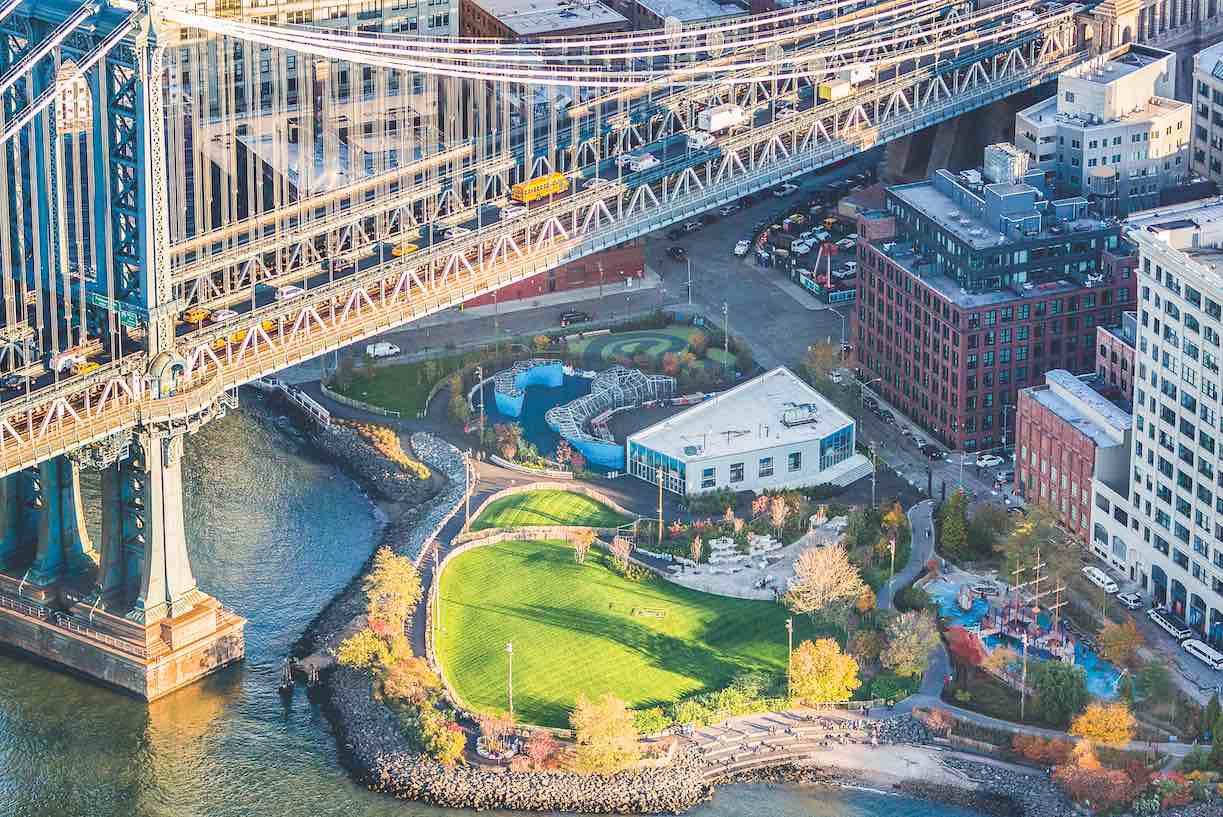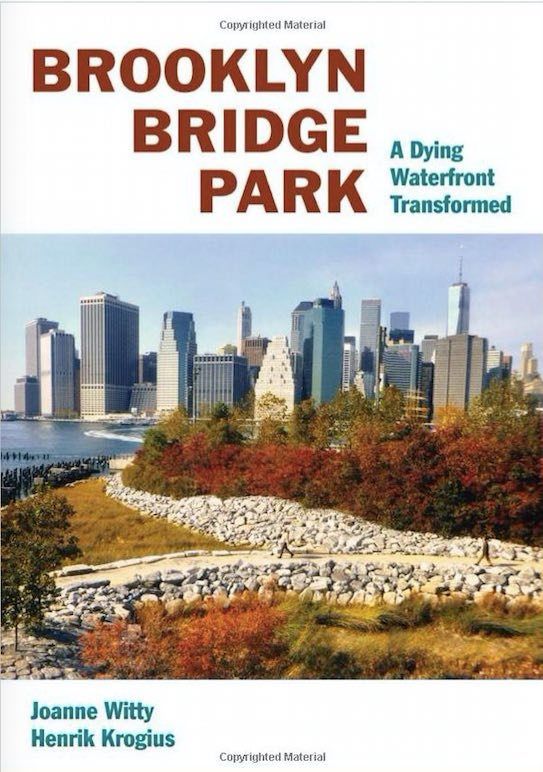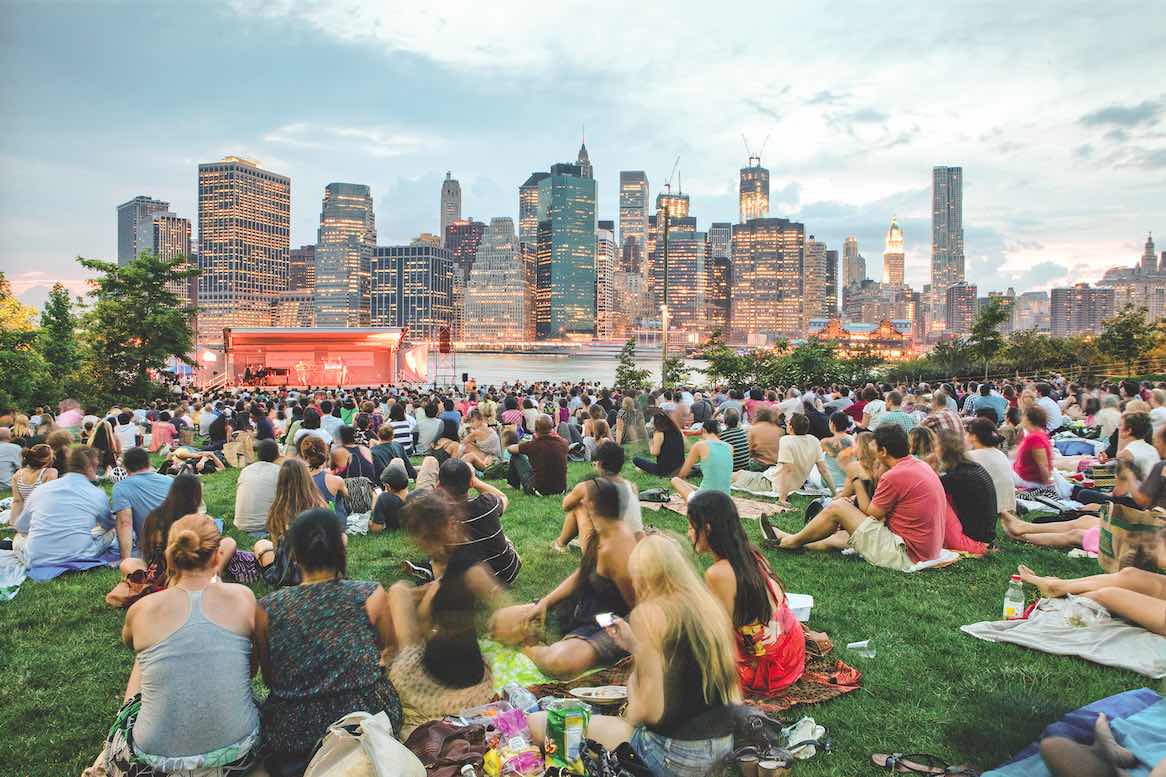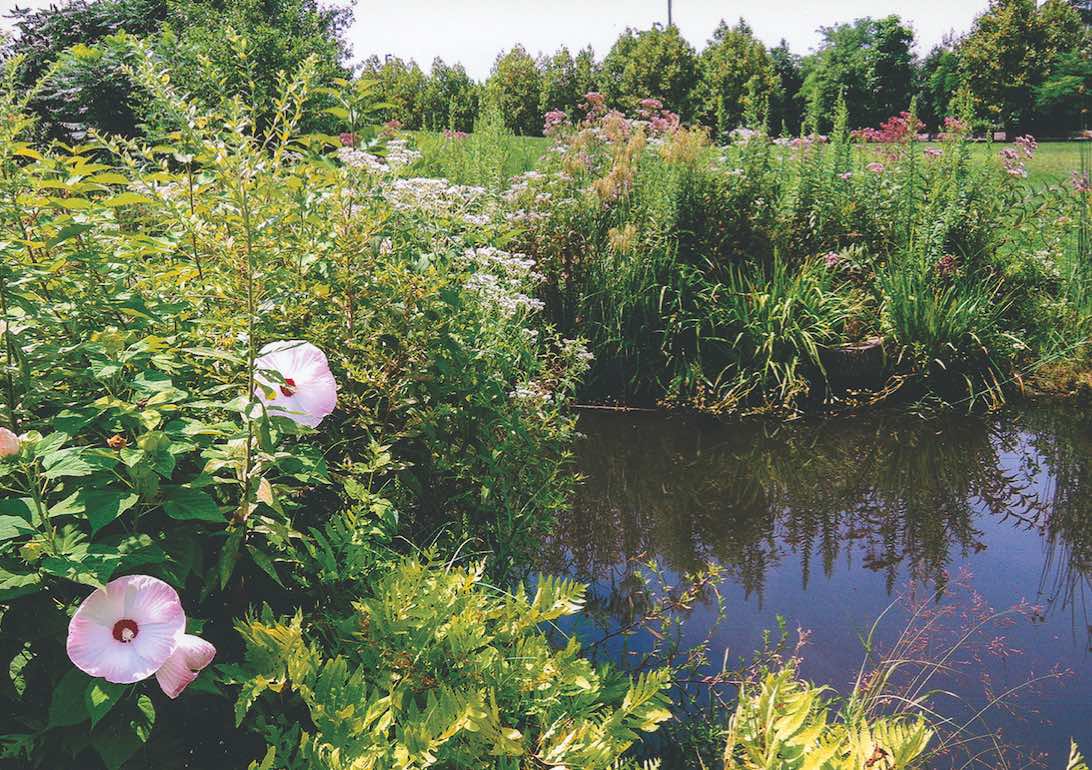‘A Dying Waterfront Transformed’: Digging Into The History Of Brooklyn Bridge Park


With its breathtaking views of the Brooklyn Bridge, New York Harbor, and the Manhattan skyline, acres of lush landscapes, and a diverse array of cultural and recreational activities to choose from, one can easily overlook the fact that the creation of Brooklyn Bridge Park was a complicated, decades-long struggle rife with drama and politics.
Joanne Witty knows all about it—a lawyer, environmentalist, and activist, she has worked on the development of Brooklyn Bridge Park for 18 years.
Along with Henrik Krogius (a former Brooklyn Heights Press editor who passed away in October after covering the development of the park since the 1980s), Witty has written Brooklyn Bridge Park: A Dying Waterfront Transformed, a behind-the-scenes look at one of New York City’s largest and most significant public projects in recent times.

The site has a rich past—George Washington was defeated at the Brooklyn Waterfront during the Revolutionary War while trying to defend New York Harbor from the British. In the late 19th century, the formerly industrial site was the country’s coffee and sugar capital (Arbuckle Brothers roasted, packaged, and distributed its coffee beans from a warehouse located on John Street), and by the 20th century, it served as one of the busiest working waterfronts in the world.
By the 1970s much of the waterfront business began to decline. In 1984 the Port Authority, who owned this land, stopped cargo shipping operations and decided to sell the piers for commercial development. Locals joined forces against the Port Authority’s plan to build along the waterfront and the idea of creating a public park was born.
While a great idea, it remained just that for over 10 years. Governor Mario Cuomo originally supported the development project, but after losing his re-election there wasn’t any progress until 1998 when Brooklyn Borough President Howard Golden established the Local Development Corporation. Consisting of 15 community members, who eventually elected Witty as president, the LDC oversaw a year-long planning process for the vacant piers. (The LDC is now the Brooklyn Bridge Park Corporation in which Witty serves as Vice Chair to build and operate the park.)
Witty explains over the phone, “There wasn’t really a feasible plan until we did this public process. We came up with a master plan that was supported by everybody, all the local officials, all the communities all over Brooklyn…”

While an exciting and rewarding project overall for Witty, the long process of developing Brooklyn Bridge Park proved challenging throughout the years. “I found the whole community process so exhilarating in the beginning. It was a new thing… We were having meetings on Friday nights, Saturday during the day, Monday during the day, to get all kinds of different people to come. It was very exciting…. I felt, ‘If you engage people, it works.’ However what I also learned is over time it is extremely difficult to maintain consensus, because the people who were there then are not there now…. They weren’t there when it was explained exactly why we had to do it this way and not that way….”
The park initially got funding due to “term limits and politics.” Witty explains that Brooklyn Borough President Howard Golden “had been a huge supporter of the park, and he put money in the budget [but] he was leaving office….” Witty had approached Local Council Member Ken Fisher for initial funding for the park.
Fisher was allegedly upset with Golden because the outgoing borough president had not supported Fisher’s run to replace him. Fisher told Mayor Rudy Giuliani’s administration that “Golden had put money into the budget for the park and was going to name it after himself.” Not keen on this idea, the mayor’s office blocked it by putting “$50 million into the budget over some number of years,” which was ten times the amount that Witty had initially asked for from Fisher.
State Senator Marty Connor then used this information to try to convince Governor George Pataki for additional state funding for BBP. Witty says it was widely known that the mayor and governor did not get along and that Governor Pataki “really viewed [Brooklyn Bridge Park] as his project.”
He had provided some money for the project but was reluctant to offer more, so Connor informed him that Mayor Giuliani had given $50 million to BBP, even though at that point, “the city had not wanted to be involved in the park at all.” The governor was still unmoved.
Witty says then, “the mayor’s office was calling me because they wanted to have Brooklyn Bridge Park featured in the mayor’s [upcoming] state of the city address…and they were asking me for details…I told Marty Connor what was going on, and Marty called the governor…”
Connor informed Governor Pataki of Giuliani’s plan to mention Brooklyn Bridge Park in his speech. Pataki, whose state of the state address was also coming up, was finally swayed to give BBP $85 million and made an official announcement about the state grant before Giuliani’s speech—reclaiming the Brooklyn Bridge Park project as part of his legacy and one-upping the mayor.

Brooklyn Bridge Park’s master plan always included a self-sustaining—and polarizing—financial model requiring commercial revenue coming onto the site to go toward paying for the park’s maintenance. After consulting with the community, Brooklyn Bridge Park decided on “residential housing because it generates the most revenue in the smallest footprint and is compatible [with the project] compared to big-box retail, offices, parking, or anything else that can generate revenue there.”
When BBPC proceeded with the housing plan to create revenue for the park’s upkeep some members of the community became outraged, wondering, “How can you say it’s a park if it has housing?” Witty explains, “People have been criticizing us for privatizing the park because we have the housing, and the truth is that we had initially had an incredibly democratic process that came up with the master plan. Everybody was heard.”
Further complicating the situation, after Mayor Bill De Blasio took office, his administration asked the Brooklyn Bridge Park Corporation to include affordable housing in their plan. “All our other projects were market [rate] because our theory was, ‘if you’re trying to raise the most money in a smaller place then you’re going to [have to] do market projects.’” If BBPC wanted to continue receiving city funding, they had to comply with the mayor’s request. As Witty says, “how can you argue about [affordable housing]?”
Locals already opposed to the housing plan had no problem arguing about the addition of affordable units. While they said affordable housing is “a very noble idea,” they didn’t think it belonged in the park. Since the plan stipulated BBPC would only build as much as needed to cover the cost of the park, opponents believed if BBPC could afford to include affordable housing on the site, then the Corporation must be earning enough revenue.
Witty says this led to accusations that the BBPC was lying about their projections, that they “didn’t have the right numbers for property values. Our arithmetic was wrong, and our numbers for the maintenance for the piers were all wrong….” Angry community members have taken Brooklyn Bridge Park Corporation to court over this argument.
Another point of contention (and litigation) stems from the Pierhouse Complex, the 3-building development located on Pier 1. “It arose when the Pier 1 project was almost done. It was post [Hurricane] Sandy and the first bulkhead went on the hotel….” Due to the impact of Sandy, bulkheads containing the mechanicals and generators had to be placed on the hotel’s roof, exceeding a 100 feet height cap by 30 feet—conflicting with an agreement made years earlier (between Wendy Leventer, the former President of the Brooklyn Bridge Park Corporation and the Brooklyn Heights Association’s advisory committee) to preserve views of the Brooklyn Bridge from the Brooklyn Heights Promenade.
According to Witty who lives in Brooklyn Heights, “I have people who don’t speak to me.” She adds, “My house is right opposite from the new construction. I look out my window and I see [the building], and you know what, I’m going to survive.”
She claims that community members opposed to the project have verbally abused her and her park colleagues—even throwing rocks through some BBP team members’ windows! She says, “It’s discouraging that people are behaving this way over this beautiful park.”
While the project has been a lengthy and trying experience, lasting through 5 governors and 3 mayors, Witty still talks about the park with enthusiasm. She praises Michael Van Valkenburgh Associates’ thoughtful, refined, and sustainable design of the 85-acre park spanning 1.3 miles along the East River, with park benches made from repurposed pine salvaged from the careful deconstruction of the Cold Storage Building, a 19th century facility that was located on Pier 1.
Granite salvaged from the Roosevelt Island Bridge and Willis Avenue Bridge projects was repurposed to create the “Granite Prospect,” the towering set of steps overlooking the water on Pier 1, and the “Granite Terrace” located on Pier 3.

Soil and fill material were procured from an MTA project, providing the material to create portions of the park’s unique topography. Berms were created for sound attenuation to reduce the amount of traffic noise from the adjacent BQE. A system of tubes and cisterns collect rainwater underground to irrigate the park’s lawns and gardens, adding to its high level of sustainability and resiliency.
When Hurricane Sandy hit in 2012, the park’s naturalized shoreline edges “allowed the waves to come in and then go out again with very little damage.” Witty explains that the Van Valkenburgh team “were very much aware of the data on climate change” and understood that strong waves hitting bulkheads, or hard edges typically found on waterfronts, would have caused significant damage. “Our park was under water during Sandy. All of our piers were under water and the water washed back out,” with minimal damage.
With sections of the park opening incrementally since 2010, Witty says it still isn’t complete. Work on the Brooklyn Bridge Plaza, the area directly under the Brooklyn Bridge, can begin now that the Department of Transportation’s bridge repairs are done, and infrastructure studies for a highly-anticipated ice skating rink and swimming pool are being conducted.
When asked what her favorite part of the park is, Witty takes a moment to consider her options before answering, “I really love the [Squibb Park] Bridge.” The bouncy, 400-foot, wooden pedestrian bridge that connects Brooklyn Heights to the park has been closed since August 2014 due to structural problems. Witty promises, “It’s going to reopen this spring. It’s been totally reengineered and it won’t be quite as bouncy but I think the bridge is so quintessential…where else can you walk down this crazy bridge that zigs and zags and moves around?”
Brooklyn Bridge Park: A Dying Waterfront Transformed took Witty and Krogius five years to write, reviewing the Brooklyn Heights Press archives Krogius had collected over the decades to remind them of the project’s extensive timeline and milestones. Witty says she believes it is a “hopeful book” that shows “it is possible to get something like this done.”
“If you had seen the site when we started, it was pretty unpromising. It was just this flat, black-top [site] with ugly warehouses that were leaking…places in the concrete and asphalt that were sinking…. [The site] was long and thin…. It took some creative imagination by some talented people to [take] the ideas that were heard in these [planning] sessions about what people wanted and transform that into a park.”
She continues, “The idea that we’ve been able to do it and that it was, in large part, community supported and there was a huge level of community engagement…. All of that I think is very hopeful for other communities that want to do something like this.”
Witty clearly loves a challenge. She is currently a member of the Freshkills Park Alliance whose goal is to transform the 2,200-square-foot, Staten Island landfill into a public park. Despite all the trials and tribulations, she says overall Brooklyn Bridge Park “has exceeded my expectations. That’s partly because I saw it before and if you had seen the site before you would have been hard-pressed to think it could ever have looked like this.” She adds fondly, “I love the fact that it’s a destination for people from far and wide.”




